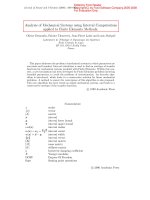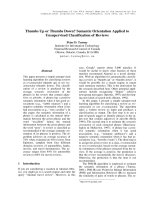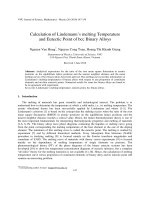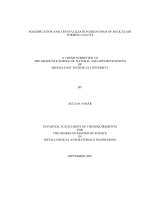Caculation of melting temperature applied to FCC alloys
Bạn đang xem bản rút gọn của tài liệu. Xem và tải ngay bản đầy đủ của tài liệu tại đây (946.41 KB, 4 trang )
<span class='text_page_counter'>(1)</span><div class='page_container' data-page=1>
VNU. JOURNAL OF SCIENCE. Mathem atics - Physics, T-XX. N03AP, 2C04
<b>CALCULATION OF MELTING TEMPERATURE </b>
<b>APPLIED TO FCC ALLOYS</b>
<b>T ran T ru n g D u n g , N g u y en Van H ung</b>
<i>D epartm ent o f Physics, College o f Science, V N U</i>
Abstract: A method for calculation of melting temperature and application to fee
alloys have been developed based on the vibrational or Lindemann theory.
Analytical expressions for the effective force constant, mean square
displacement and Lindemann melting temperature have been derived. This
temperature depends on the mass proportion of alloy components. The <i>eutectic </i>
point has been determined. Numerical calculations have been carried out for the
fee binary alloy CuAg, and the resuits are found to be in good agreement with
experiment.
1. I n t r o d u c t io n
<b>The melting of materials, especially of alloys, is studied widly by theory and by </b>
<b>experiment [1-10]. The vibrational theory has been succesfully applied by Lindemann and </b>
<b>others [1-5] according to which an alloy is melted when the atomic mean square </b>
<b>displacement reaches an critical value at a melting temperature, i., e., the Lindemann </b>
<b>temperature. The melting is also studied recently experimentally by the X-ray absorption </b>
<b>fine structure (XAFS) [7] for crystals.</b>
<b>The purpose of this work is to develop a vibrational theory for the melting of binary </b>
<b>alloys. Our development is the derivation of analytical expressions for the effective force </b>
<b>constant, mean square displacement (MSD) and Lindemann melting temperature. The </b>
<i><b>derived theory is focus especially to eutectic alloys, which are the binary alloys having the </b></i>
<b>phase diagram with two melting curves, the point connecting this two curves is called </b>
<i><b>eutectic p o int corresponding to the alloy-ratio at which the alloy has the lowest phase </b></i>
<b>trasition temperature. Numerical calculations have been carried out for the fee binary alloy </b>
<i><b>CuAg showing the m ean m elting curve, i., e., the dependence of melting temperature on the </b></i>
<i><b>mass-ratio of eutectic alloy CuAg, and the existence of a ratio corresponding to the </b></i>
<i><b>minimum melting temperature. The calculated ratio and eutectic temperature of CuAg are </b></i>
<b>found to be in good agreement with experiment [3, 10].</b>
<b>2. T heory</b>
<b>We deal with the alloy lattice including two metals having face centered cubic </b>
<b>structure (fee).</b>
<b>If each of fee lattice shell has on average s atom s of type 1 and 4-s atom s of type 2, we </b>
have the mean <b>net displacement :</b>
U „ 4 £
í
[•u,,-*<4- s>u!,)el''R'
«>
</div>
<span class='text_page_counter'>(2)</span><div class='page_container' data-page=2>
<i>Calculation of melting temperature applied to...</i>
4 5<b>We calculate th e MSD or Debye-Waller factor (DWF) [8, 11] </b>
<i>w </i> <i>u \ ' Uq </i> <i>Q</i>
<b>We have th e lattice energy</b>
E = r i > X ™ J u t q I . N ...M , » , ! |U l I + N(4
<b>-the m asses of atoms of typ </b>
<b>energy of fee lattice shell</b>
<b>where, Mj, M2 are the m asses of atoms of types 1 and 2, respectively. </b>
<b>We have th e mean energy of fee lattice shell</b>
<b>We have th e expressions for 1 and all 3 polarizations, respectively</b>
<b>[K uj; 4 4 ) f c f i </b> <b>| K u | - K‘k f - 3 « k '[- * S 7 (4 ■ "’I V "</b>
<b>Hence, the Debye-Waller factor is given by</b>
<b>1 </b> <b>i l s » * </b> <b>m . M l</b>
<b>1 </b> <i>Ỉ</i>
<b>Since we consider the melting, so it is sufficient to take the hight temperature quantity</b>
3 [M.;s t ( 4 - s ) M , ^ T K z (8)
<b>8 </b> <b>M ^ k S é ỉ</b>
<b>From(2) and (6) we obtain</b>
Z u „
<b><sub>K2[s + (4 -s)m ]2 </sub></b><b>Comparing the following expressions for the lattice energy</b>
E = £m u|u' „ | . X Z M »|u i " i [ ■ Z Z M i.“ ỉ l U k» if ; (10)
<b>we obtain </b> <b>X M k[t'ta|2 * I H H l W * • </b> <b>( u )</b>
k,n k.q
<b>Using the expressions</b>
<b>- (</b>
<b>m</b>
<b>;) </b>
<b>kJ “(</b>
<b>m</b>
<b>^W </b>
<b><12)</b>
we o btain :
<b>i ? w - ’ZkT</b>
<b>Hence, the mean value o f vibrational squared amplitude is resulted as</b>
<b>- I Y lu I2 - </b> <b>36m2/»2T</b>
<b>N n </b> <b>2n </b> <b>Ml [s + (4 - s)m]kB0j}</b>
(13)
</div>
<span class='text_page_counter'>(3)</span><div class='page_container' data-page=3>
4 6
<i>Tran Trung Dung, Nguyen Van Hung</i>
<i><b>The lattice will be melted when this value reach a crictical value x j r *</b><b>. where r,</b></i><b>is </b>
<b>the radius of W igner-Seitz lattice shell. From this we determined th e Lindemann's melting </b>
<i><b>temperature Tm</b></i>
<b>[sM2 + (4 -</b>s)M] ]
<b>4-7prI|u>.r</b>
<i>tr</i> N r s “
<i><b>We use (15) to calculate the melting temperature of CuAg alloy at eutectic mass </b></i>
<i><b>proportion 71,9% Ag. Defining t as the percent mass ratio of Ag in alloy, the average </b></i>
<b>number of Ag atoms appeared in each alloy lattice shell is given by</b>
<b>(16) </b>
<b>e take</b>
<b>4 .t</b>
<b>m (l - 1) + 1 </b> <b>M('u</b>
<i><b>To consider the dependence of X and m on atomic m ass proportion of alloy, ' </b></i>
<b>average</b>
- - -fr-O -W M A g /M c J l + VÂ ^ A = [ t- a - t) (M AK/Mru) f<b>+4ta-t)CM cu/M Ag). </b> (17)
<b>2(1 - t)</b>
<i><b>The parameter X after taking average is given by </b></i>
<i><b>l'XAg +</b></i>
<b>16</b>
<b>U sing (15), (17) and (18), we perform the investigation o f the dependence of alloy </b>
<b>melting temperature on its mass proportion (see the figure).</b>
<b>3. N u m erica l ca lc u la tio n a n d d is c u s s io n s</b>
<b>Now we apply the expressions derived in the above section to numerical calculation. </b>
<b>The results are compared to experiment [3, 10]. Using the atom m ass of Cu and Ag we </b>
<b>obtain t = 0.719 , s = 2.4. The caculaled result of the melting temperature of CuAg alloy at </b>
<i><b>eutectic m ass proportion 71.9% Ag is 1064.2 K. It agrees with th e experimental result (1053 </b></i>
<b>K) with an accuracy of 3.85%.</b>
</div>
<span class='text_page_counter'>(4)</span><div class='page_container' data-page=4>
<i>Calculation of melting temperature applied to...</i>
4 7<b>The dependence of the melting temperature on the mass proportion of the component </b>
<b>elem ent Cu and Ag in the binary alloy Ag is calculated and the result is illustrated in </b>
<b>Figure 1. This curve has a minimum at the mass proportion 71.2%Ag corresponding to the </b>
<b>melting temperature 1170K and the experimental information from the phase diagram of </b>
<i><b>CuAg alloy gives us the eutectic point with mass proportion 71.9%Ag and minimum liquid </b></i>
<b>phase transition temperature 1053 K, respectively. Based on the comparison, we have </b>
<b>concluded that, m ass proportion of Ag the alloy ratio corresponding to the minimum </b>
<i><b>melting point of this theoretical curve is the eutectic ratio, (the relative difference between </b></i>
<b>experiment and theory with respect to this ratio only is 0.97%).</b>
<i><b>The above theoretical curve above is compatibly the m ean m e ltin g curve for a binary </b></i>
<b>alloy. However, the existence of a minimum point of this curve is intim ately connected with </b>
<i><b>the eutectic alloy of CuAg experimental diagram. Therefore, to somewhat, we can-provide </b></i>
<b>an explaination of the existence of a special point with minimum liquid phase transition </b>
<i><b>temperature (eutectic point) in the diagram of CuAg alloy.</b></i>
<b>1. </b> <b>C o n clu sio n s</b>
<b>Based on the Lindemann’s theory we developed further the vibrational theory. Our </b>
<b>development is the derivation of analytical expressions for th e melting temperature </b>
<i><b>depending on the atomic m ass proportion of a binary alloy, i. e., the m ean m elting curve</b></i>,
<i><b>and a method for determination of the eutectic point.</b></i>
<i><b>The calculated m ean m elting curve and the eutectic p o in t for the binary alloy CuAg </b></i>
<b>are found to be in a reseanable agreement with experiment. This curve provides the </b>
<b>information on the dependence of alloy’s melting characteristic on its mass proportion. The </b>
<i><b>m ean m elting curve has pointed out an ratio o f Cu-Ag alloy having the lowest melting point, </b></i>
<i><b>this atomic m ass ratio nearly coincide with the eutectic ratio in the experimental diagram of </b></i>
<b>this alloy.</b>
<i><b>A cknow legdm ent. This work is suported in part by the basic science research project No. </b></i>
<b>41.10.04</b>
<b>R e fer en ces</b>
1. F. A. Lindem ann, <i>z . Phys.</i> 11 (1910) 609.
<b>2. </b> <i><b>N. Snapipiro, Phys. Rev. B 1 (1970) 3982.</b></i>
3. Y. S. Touloukian. R.K.Kirby, R. E. Taylor, p. D. Desai, <i>Thermal expansion, Metallic,</i>
<i><b>Elements and Alloys. Thermophysical properties o f matter, Vol. 12, IFI/Plenum, New York- </b></i>
<b>Washington. 1975.</b>
4- H. H. W o lf and R. Jeanloz. <i>J. Geophys. Res.</i> 89 (1984) 7821.
<b>5. </b> <i><b>R. K, Gupta, Indian J. Phys. A 59 (1985) 315.</b></i>
<b>6. </b> <i><b>Charles Kittel, see Introduction to Solid State Physics, 3rd Edition (Wiley, NewYork, 1998).</b></i>
<b>7. </b> <i><b>E. A. Stern, p. Livins, Zhe Zhang, Phys. Rev B, Vol. 43, No.11 (1991) 8850.</b></i>
</div>
<!--links-->









